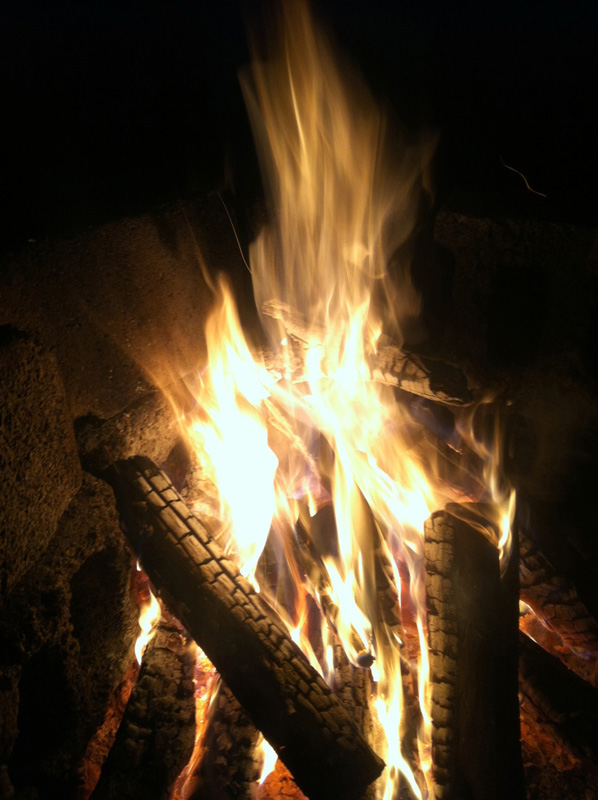A pandemic is a transmogrifying thing. As surely as any earthquake or tsunami, it can violently grab a complacent society and shake it by the lapels — not by suddenly turning stability into movement, or land into sea, but by turning custom into chaos — putting routine to rout, invalidating long-held habits and assumptions, and leaving us to salvage a new set of sensibilities from the rubble of the old.
Although the current pandemic has already stretched across four seasons twice, some of our new sensibilities have yet to be shaken out. The most profound invalidation was the loss of our ability to fearlessly share the same air. Suddenly, we were compelled to reconsider the fungibility of humanity in shared public spaces — something which we have always taken for granted, and upon which countless social customs and business models have been built.
For example, the temporary closure of restaurants and bars reminded us of the important place these public gathering places hold in the Western concept of socialization. Yet many have closed permanently, and many of those that remain continue to struggle to maintain their viability as a business.
Taking it outside
One of the keys to restaurant survival has been to find ways to help customers feel both comfortable and safe at the same time. Outdoor dining has thus seen a rapid and hasty boom. In the warmer months, and especially in warmer climates, many restaurants now disgorge their interiors into the street, making a casual neighborhood walk into an eclectic obstacle course of mismatched tables, misplaced chairs, and maskless diners.
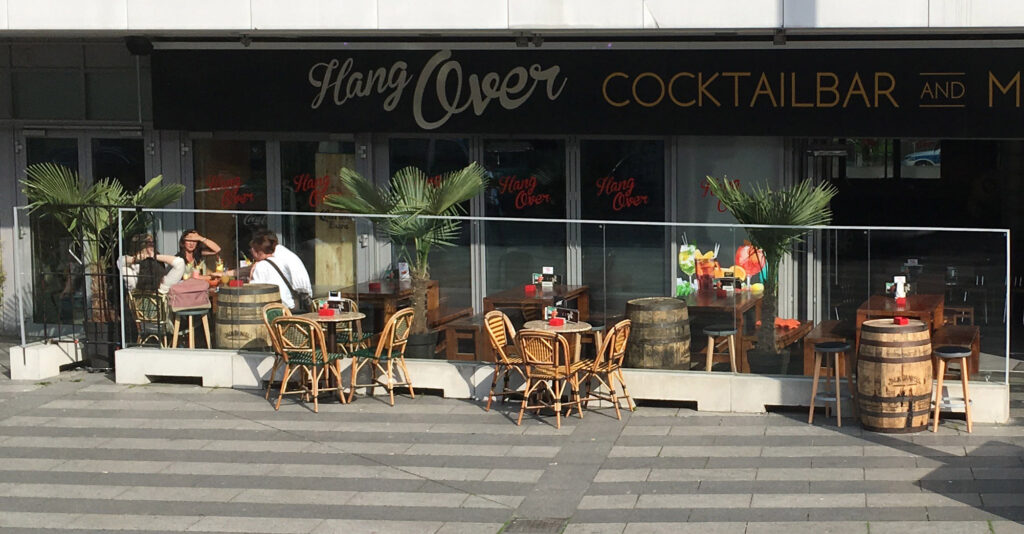
In colder climates, a summer of outdoor dining might tentatively commence as soon as spring begins to emerge, and linger well into a rapidly darkening autumn. In these transitional seasons, people have learned to thicken their skins accordingly. As clichés tend to rise and fall with the times, we have become increasingly acquainted with a once-obscure and supposedly Scandinavian proverb, that “there is no bad weather, only bad clothing.”
But there is a limit. It is unlikely that a restaurant in a continental climate can be sustained during the winter months entirely on the business of people who have worn good clothing. Dining outside in Detroit on even the sunniest January day has likely been tried, and found unsatisfying. Even those wearing the best clothing still must divide their attention between their companions and other urgent concerns, such as wolfing their hot food before it turns cold, and contemplating the odd experience of having their cold drinks grow colder. And ultimately, restaurateurs cannot control how people dress. Even in the transitional months, when a milder chill might support a borderline case for dining al fresco, something more seems to be needed.
Bumping into an old friend
On that note, let’s meet the hospitality sector’s new darling: the outdoor fire.
Heating the outdoors was once considered the ultimate example of futility and wastefulness, but our sensibilities have adjusted, elevating it to a canny example of good business sense. Many a downtown dusk is now greeted with every variety of furnace, fireplace, and flamethrower that can be pulled out of a restaurant supply catalog.
The success with which fire can successfully heat the outdoors is still open to a lopsided debate. It can’t — but it can make it seem warm enough for customers to consider sitting outside, long enough to visit and run up a bill. In this sense, many of these urban fires are acting as what might be called “fire features,” in analogy to water features, such as fountains or waterfalls. Just as the sight and sound of flowing water conveys a sense of coolness, fire conveys a sense of warmth. Although it might provide little actual warmth, a fire feature lends at least an atmospheric ambience that is warm, welcoming, and perhaps a bit apologetic.
Thus, just as pedestrians have been brought into casual contact with diners, both have been brought into casual contact with fire. One might even say that we as a species are becoming reacquainted with fire, one of our first technologies. But it’s clear that we’ve forgotten a lot.
Fire vs. flame
In fact, our old friend seems to have changed. Most of the fire features we see on our streets are better understood as flames than as fires. What’s the difference? For one, what I call a flame is merely the result of combusting a stream of gas or liquid fuel, by means of a burner that delivers the fuel into a combustion zone. This would include the propane-fueled patio heaters and tall torches that are the bulk of the fire features found on the streets. As fires go, a gas flame is warm and reliable, but rather dull. Watching a flame for a few moments is enough to grasp the entire spectrum of its behavior. Like the flame of a cigarette lighter, it’s a one-trick pony. In this consistency, there is efficiency and reliability, but there is no drama.
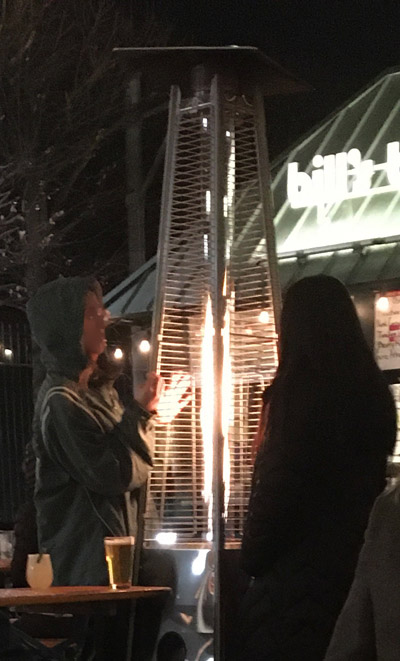
A real fire, on the other hand, is a drama. By a real fire I mean the open air combustion of natural wood. This is the fire that we fondly remember from our younger years as a species. This fire was not at all dull, but was a great entertainer and conversationalist.
When dry firewood is piled up and set aflame, a host of processes begin a tortuous path together — commanding attention, participation, and contemplation. First there is the kindling of the fire — the process by which the miniscule flame of a match goes forth to seek its fortune. As the flame licks up the side of a log or kindling stick, we are compelled to follow its success at convincing the rest of the wood to follow suit. Will it “catch?” A wisp of smoke may rise, suggesting that perhaps the flame has flickered out. But as often as not, it recovers and presses on. At some imperceptible juncture, we accept that the flame has become a fire. Even then, we know instinctively to treat it gently for a time, perhaps nurturing it with a few twigs or small sticks, until it finally fledges into a self-sustaining entity.
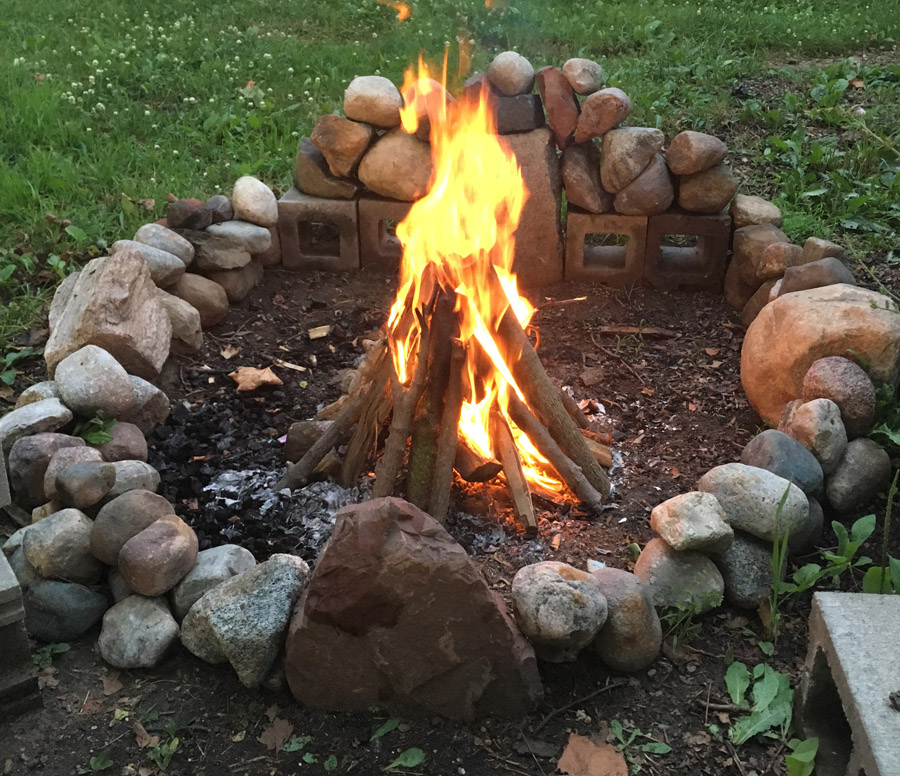
From there, a fire becomes both the stage and cast of a riveting drama. Even a well-built bonfire is not entirely predictable in its progress, its heat, or its duration. It might become hotter than expected, or die down prematurely, or become smoky, or a spark might fly out and burn a hole in our favorite shirt. The heat does not emanate evenly, and we might overheat our palms or our pants as we constantly seek the comfort zone. From time to time, we might hover over it to shift a log to a better position, flirting again with a burned finger or a singed lock of hair. Fraught with such perils, inviting a fire into your social circle is an inclusive and participatory act, that builds a bond of common experience as the performance unfolds before the group.

It’s been a long time
But sadly, while it has always had a warm demeanor, the fire that we once knew continues to raise doubts about the sincerity of its friendship.
Whether in the guise of a wood-fueled bonfire or a fossil-fueled flame, it continues to emit pollutants that harm human health, and that, we now know, have also been harming the planet. We used to tolerate this behavior, but it hasn’t improved, and we are on the verge of losing patience.
We know, then, that its sudden reappearance could turn out to be complicated. But it has come bearing gifts. In the spirit of inclusion and forgiveness, and for old time’s sake, let’s hear it out for a bit.
In a way, even before the pandemic, it might be said that we had already forgotten how to share the same air — socially, that is. Bars and restaurants may be an important social feature of our society, but they do not facilitate every type of socialization. Recently, I found that one of our pandemic accommodations may hold at least a little promise for a net improvement over our pre-pandemic sensibilities.
Some establishments have begun to recognize the attraction of a real fire, and have taken the once-unthinkable step of placing portable fire pits among their outdoor seating. On one hand, this development is a bit troubling — wood fires are somewhat unpredictable, and they emit pollutants, as do gas flames. But when visiting such places, I have been surprised to discover that — unlike a gas-fueled flame — a fire has the unique ability to bring strangers together on a cold night, breaking the plane of unfamiliarity, and encouraging separate groups to mingle and converse, where such mixing would otherwise be highly unlikely.
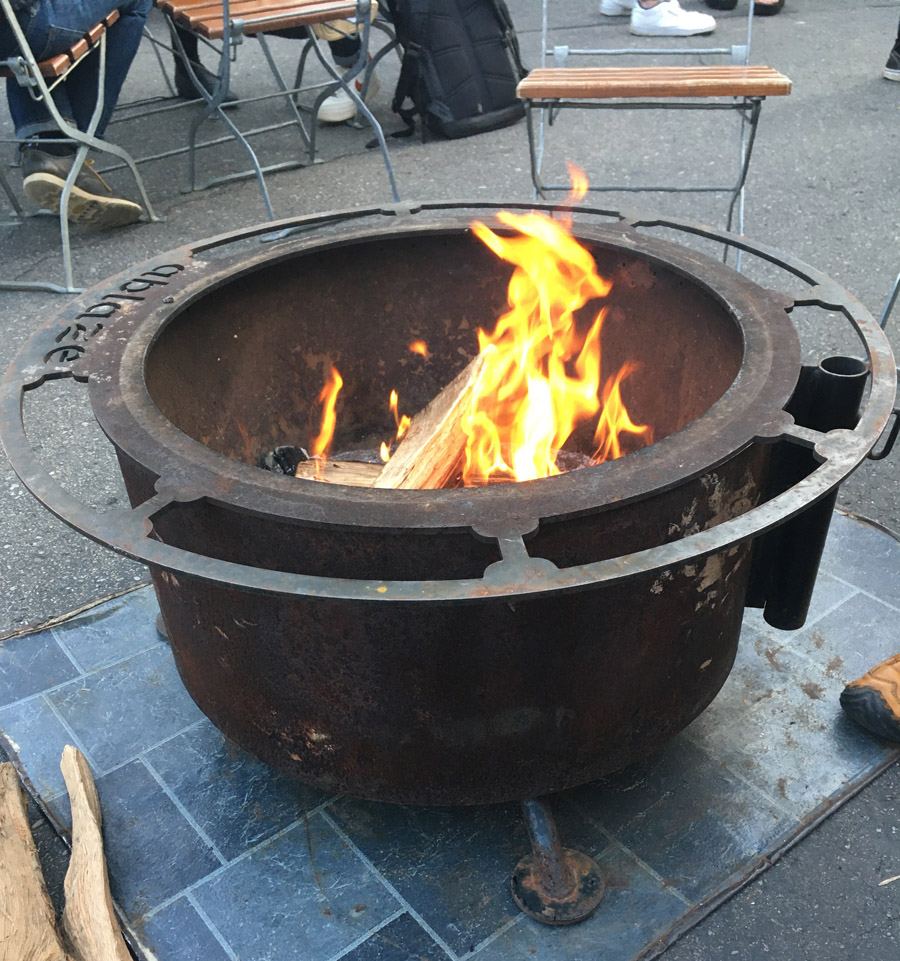
Moths around a fire
One chilly spring afternoon of this year, I sat with a friend in a beer garden, near a fire pit that was circled by a ring of five chairs, of which we occupied two. Soon, a woman came up to us and motioned to the empty chairs, as if to ask permission to occupy one of them, so that she could partake of the fire on this cold March evening. Of course she could. As she sat down and warmed her hands, she informed us that she had been celebrating her birthday for much of the day. This began a fifteen-minute conversation, one that took some entertaining twists and turns in her enthusiasm. Soon, she left to meet up with scheduled festivities elsewhere. But we had shared her excitement in a way that otherwise would not have occurred, if not for the allure of the fire.
Soon after, a pair of university students sauntered by with their newly acquired drinks, scoping out the seats, and asked if they could sit by the fire. Of course they could. After we greeted each other briefly, they carried on their conversation with each other, as did we. We all sat comfortably, accepting each others’ unplanned presence, united by the common bond of the fire. After some time, one of them left to pick up an order of food down the street; her companion remained, comfortably lounging in her chair, casually killing some time with her phone, silently absorbing the warmth. I briefly wondered how often a similar scene, minus the iPhone and the modern surroundings, had played out among family groups and hunter-gatherers throughout human history. Her friend then brought me back to the present, arriving with two plastic bags holding styrofoam containers of hot food. They left for a table at which to eat it together, and the chairs became free again.
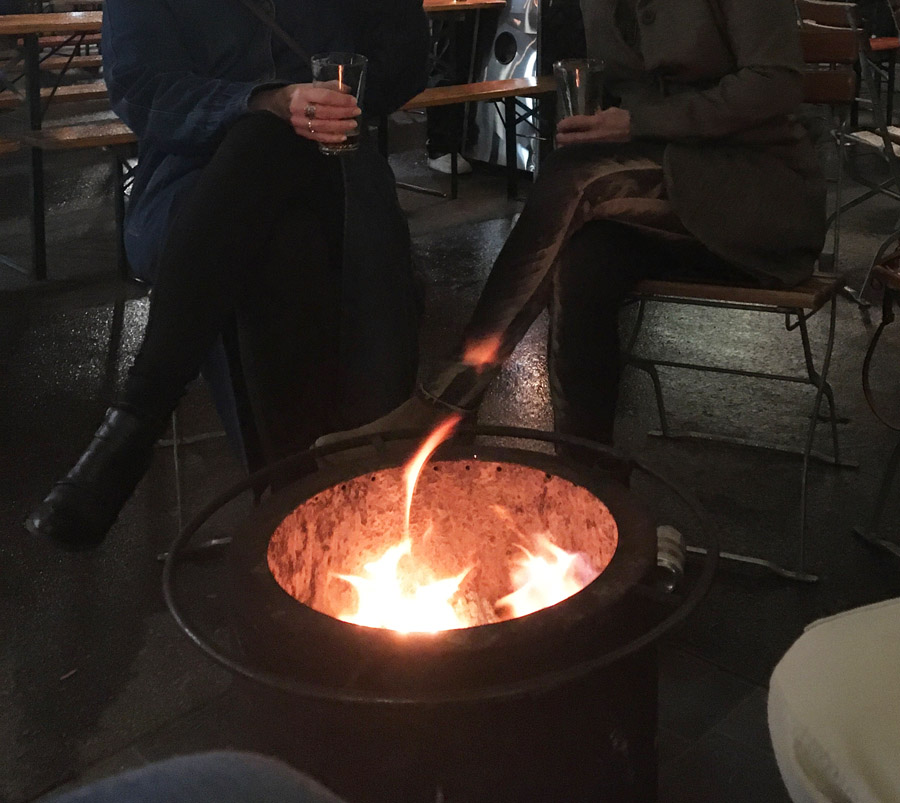
Almost immediately, a trio of students came up, composed of a couple and a solo guest who was still wearing a name tag from some social function. Again, we were politely acknowledged as apparent keepers of the fire seats. By now, perhaps we were. We waved them in. They socialized with each other, as did I with my friend. At times, we would add a chunk of wood. If we were not fire-keepers, we were at least fire-tenders. Their lively conversation complemented the crackle of the fire. Soon they moved on, to wherever roving trios go.
The musical chairs played on. Two women, who might have been a mother with her adult daughter, asked us if the chairs were available, as they obviously were. Again, as they sat, we all bantered a bit about the fire, before resuming our own conversations again. When one left for the restroom, the other began to focus on the fire, holding her palms against the radiant glow. This seems to be an innate response to a fire — one which we have apparently not yet forgotten. But flames are fickle, and she got a bit too close. Because we were all staring at the fire, she knew that her sudden pull-back had been a public performance, and so it triggered a few minutes of friendly conversation, until her friend returned.
Finally, it had gotten dark. The chill in the air was growing, and the crowd was thinning, and the two women had left. Nearby, a pair of students were standing on either side of a propane flame tower, chatting through the transparent glow of the flame, nearly hugging it with their arms to capture what little warmth it offered. One of them left for the restroom, leaving her friend alone for a few minutes. No longer distracted by the person she had arrived with, she was now able to overhear our conversation — which just happened to be about the difference between a gas flame and a real fire. Unexpectedly, she suddenly shouted over to us, indicating her agreement, and quite emphatically. She then apologized for having “eavesdropped” — but of course, spoken conversation has no greater claim to privacy than the message on a postcard, so there was no need for apology. Rather, I felt delighted that the fire had broken yet another plane of separation, from twenty feet away. When her friend returned, she found the flame tower abandoned, and her friend now chatting with us, in a chair, around a real fire. The four of us had a very pleasant conversation, talking first about fire and flame, and then our careers and our interests, as if we were not strangers at all. Soon, the venue was closing, and we all went on our way — never to meet again, but having unexpectedly shared a genuine and unscripted moment in our lives.
In all of these instances, the fire quite literally melted the ice that strangers habitually carry before them, and these strangers went on to find each others’ presence pleasant and affirmative. Even if our conversations were brief and ephemeral, they created a sense of mutual belonging and acceptance — which is commonly assumed to exist among strangers in public spaces, but is only rarely demonstrated.
The perfect mixer
Pubs, bars, and beer gardens claim a place in our society as a medium for socialization. However, in my opinion, most of them suffer from the absence of a missing element — one that we saw in action that evening.
Any public place where people can freely meet can support socialization — with the people you’ve come with, that is. What is missing is some element that allows groups to break out of their self-containment, and interact in a spontaneous, genuine, and uncontrived manner, with people they didn’t come with.
Of course, this is not always desirable; sometimes, you just want to talk with your friends. But as we saw in the beer garden, some contact between independent groups is often welcome, even if it is not specifically sought. It’s like the difference between typing keywords into a search engine to search for something specific, versus passively browsing a catalog or store aisle to see what you might stumble upon. Precision is not a replacement for serendipity. Both are essential modes of learning, and of living.
A matter of design
Traditionally, the interior design of pubs and taverns has differed from that of restaurants in ways that support the beneficial blurring of boundaries. Restaurants typically are filled only with tables, each of which provides seating for a single group, and separates it from other groups. Almost every pub or tavern has tables, too — but they also have a bar, where the boundaries are not as well defined as by the hard edge of a table. Bar seating is thus much more permeable to the incidental contact of voices, eyes, and ideas. It is a place where overhearing cannot be mistaken for eavesdropping. A good bar can turn precision back toward serendipity, and turn insularity toward receptiveness.

Yet, I have often seen an individual arrive at a pub and look briefly at the bar, but then sit down alone at a table, and proceed to spend their time reading a magazine they picked up on the way in, or studiously poking at their phone. Certainly, there are many reasons to go to a public space as an individual, perhaps to read quietly, or to work undisturbed, while absorbing the energy of the crowd. But if you are also open to expanding your social horizon, then choosing a table over a bar seat is much like bringing your own water to an oasis. Similarly, I have often seen groups of five to seven people arrive at a pub together, and then stand and sit at the bar, remaining completely encapsulated as if they had strung a virtual cordon around themselves. These groups either could not find a table, or did not realize that they might have been happier at a table. Thus, the physical format of a bar, by itself, often fails to come through on its potential. In other words, something still seems to be missing, because a lot of people aren’t doing it right.
The most successful venues, for those who are receptive to contact with others, have some sort of feature — often unintentional — that happens to facilitate mixing. For example, well-designed cafes frequently feature four large, upholstered armchairs facing the four sides of a coffee table; unlike separate tables, this arrangement is permeable specifically to individuals and to pairs but not so much to groups. When a new person arrives, often it is considered appropriate to ask if one of the open chairs is free. I’ve also seen situations where an individual might have inadvertently strung their laptop cord, or laid their coat, across the arm of an adjacent empty chair. When another person arrives and wants the chair, it forces both to explicitly acknowledge the other’s presence for at least a moment. Newspapers are rare these days, but I’ve also seen conversations start when someone asked another if an abandoned newspaper belonged to them or not. Small, unplanned events of this sort can seed a conversation. But some venues fail to support them — not by design, but by neglect of design.
However, design dare only go so far. Features that act to relax social barriers must be genuine, subtle, and uncontrived, in order to be used. Hardly anyone is going to respond to measures that are too up-front about their purpose of causing people to mix, and many will instinctively walk the other way. Singles bars and social clubs of various stripes already exist for those who are perfectly comfortable being transparent about their desire to meet others. Their flaw is that they directly confront the problem — too directly for many. When thinking of expanding their social envelope, which often means leaving an established comfort zone, people tend to want to retain their independence and their right to withdraw at any time. Retaining a certain ambiguity of purpose means retaining that control — the power to change one’s mind, to maintain plausible deniability, to dip in a toe, rather than to plunge. If this were not the rule rather than the exception, there would be far more self-declared singles bars and far more friendship clubs than there currently are. After all, not every vegetarian who’s considering going carnivore will feel comfortable walking openly into a meat market.
Just what the therapist ordered
So why did my evening by a fire at a beer garden seem to break all of these taboos and insecurities, for so many people? I think it’s because a set of chairs around a fire, on a distinctly cold evening, fits the bill on all counts.
It’s true that a fire is a drama, and is interesting to watch. But is this what drew people in? I think not. If that were the case, then a TV monitor could do the same thing. Every sportsbar has several of those over the bar, and sometimes they are even seen outdoors. They might facilitate some spontaneous conversation about the big game, but they aren’t doing what the fire did.
The difference is that on a cold night, a fire is not just a facilitator, but what I would call a “forcing function,” that actively compels strangers to mingle. To some degree, the cafes with the facing leather armchairs, or the shared newspapers, are doing this — they can exert a mild force that encourages strangers to acknowledge each other, if conditions are right. But on a chilly evening, a fire is more powerful. Merely wishing to sit by the fire is not as compelling as needing to sit by the fire, as might be true on a cold and breezy evening. This is the “force” of the forcing function. A population that has learned to largely ignore itself needs a gentle shove to overcome this habit. That night, the people who came up to us and asked to sit were not just thinking that sitting by a fire would be nice, but that they pretty much needed the fire, and had better get over the hump of asking those two strangers about it.
Importantly, the decision to join a group around a brightly burning fire also provides a bit of cover. On a cold night, a fire need not be accounted for as an artificial construct designed to make people mix — it is simply there to address the cold. On that practicality, the hesitant or self-conscious mind can attribute its decision to the need, rather than to the desire — which volunteers much less personal information than the latter.
Unfortunately, as summer approaches, I find that the fire pits at my favorite beer garden are increasingly absent. As the venue needs to be set up and broken down every day (it’s in the small parking lot of a store), the management can decide on a daily basis whether they need to keep the customers warm, or if they can instead maximize their seating space. And anyway, it seems unlikely that a fire could command the same “forcing function” effect, on a sultry summer night.
Maybe it’s for the best. Despite its newfound popularity, heating the outdoors never stopped being a wasteful activity — one that gratuitously flies in the face of the steps we urgently must take to preserve the habitability of the planet that supports us. Combustion of any kind, especially in a primitive device such as a fire pit, creates emissions that can directly harm the health of customers and innocent passersby, while harming the rest of the planet in the bargain. It does trouble me that I might be promoting the use of wood-fueled fire pits, particularly if it motivates their use in establishments where the social benefits that I’ve described are unlikely to be either sought or realized.
Like so many other human activities, the debate that arises from our whirlwind reunion with fire is fueled by a more basic truth: that we as a society are collectively unable to grasp and act upon the full consequences of our collective behavior. We are the only species that has sufficient intelligence to utilize willful denial and a disconnection from reality as survival tactics. The ability to both help and harm ourselves in a single deft motion seems to be a defining aspect of our technological character. We love fire, but our attachment is self-destructive. What to do?
On this point, perhaps we can conditionally accept a limited reprise of the wood fire as a sort of therapy for a difficult set of circumstances. But I am not going to bring out the rainbows and unicorns any further. Denial has limits, and for me, the buck stops there. Environmentally and sociologically, we need a course correction that seems unlikely to occur. But I’m still going to socialize as best I can, with the people that we are.
If pubs, restaurants, and beer gardens can claim a worthy place in our society, then a good venue is one that promotes the socialization that we need, while navigating our biases, preconceptions, and neuroses in a way that we, by ourselves, might not.
Can a small fire, on a cold night, over a few drinks, help us reconnect with a better model of reality?
If so, then I am ready to throw on another log.
§

Article and photos Copyright 2022.
To subscribe to new posts, visit https://whatshallweweird.com/subscribe/
